2025外研版高中英语必修第三册强化练习题--Unit 5 Part 2 Using language(含答案与解析)
文档属性
| 名称 | 2025外研版高中英语必修第三册强化练习题--Unit 5 Part 2 Using language(含答案与解析) | 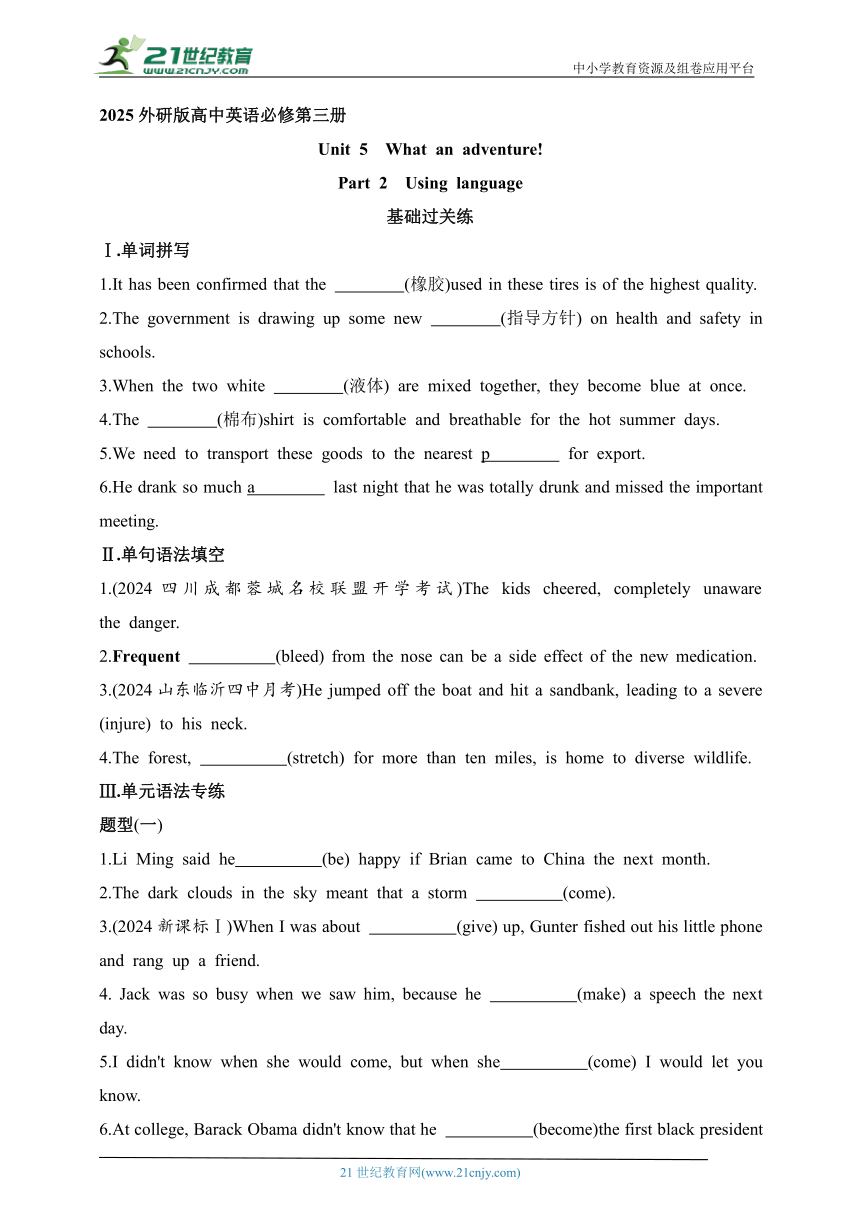 | |
| 格式 | docx | ||
| 文件大小 | 367.1KB | ||
| 资源类型 | 试卷 | ||
| 版本资源 | 外研版(2019) | ||
| 科目 | 英语 | ||
| 更新时间 | 2024-11-04 10:24:53 | ||
图片预览

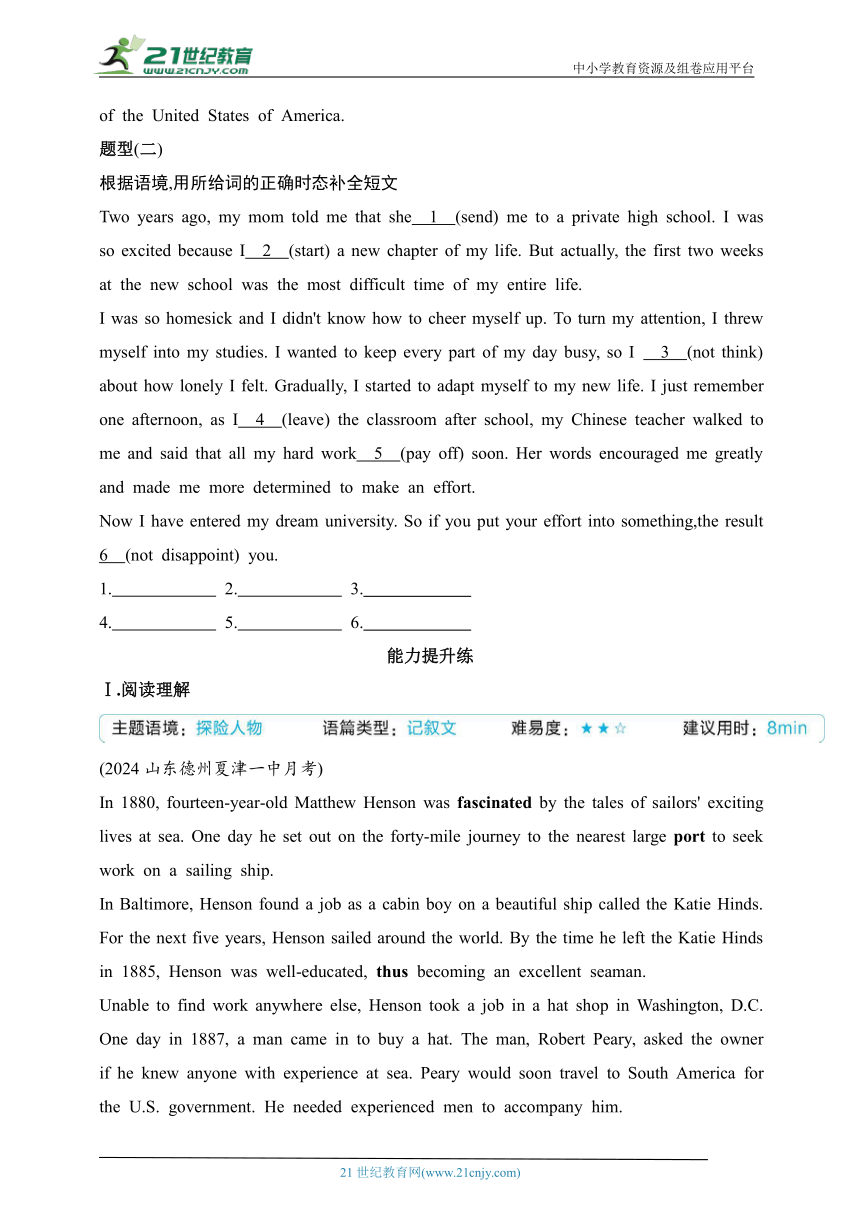
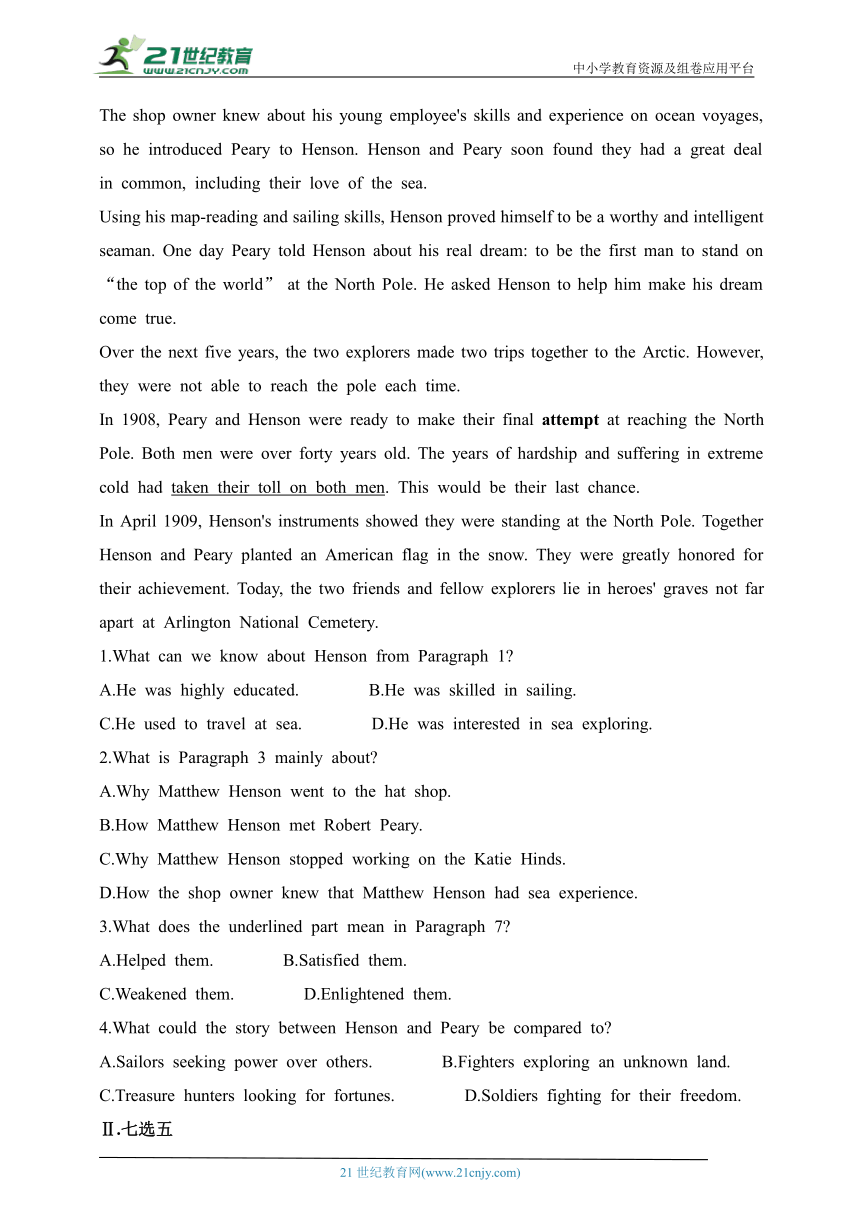
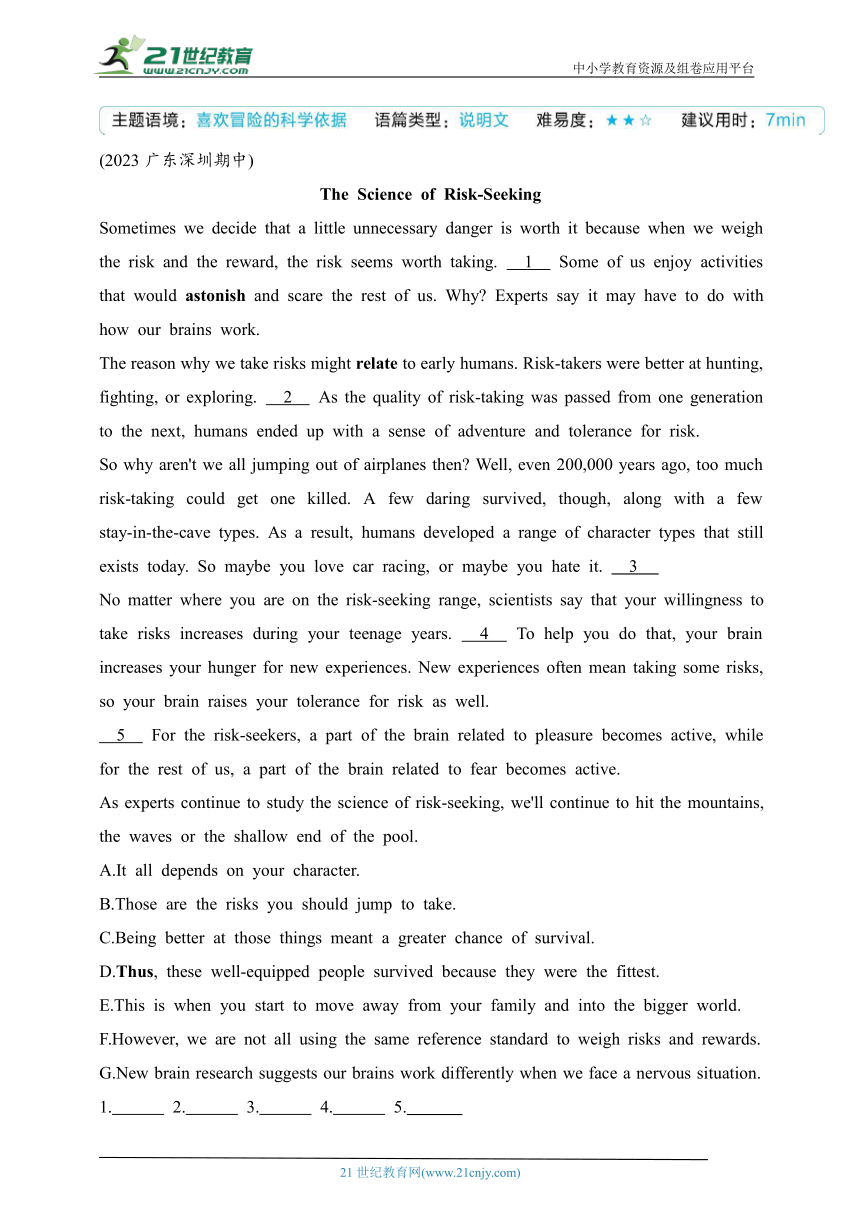
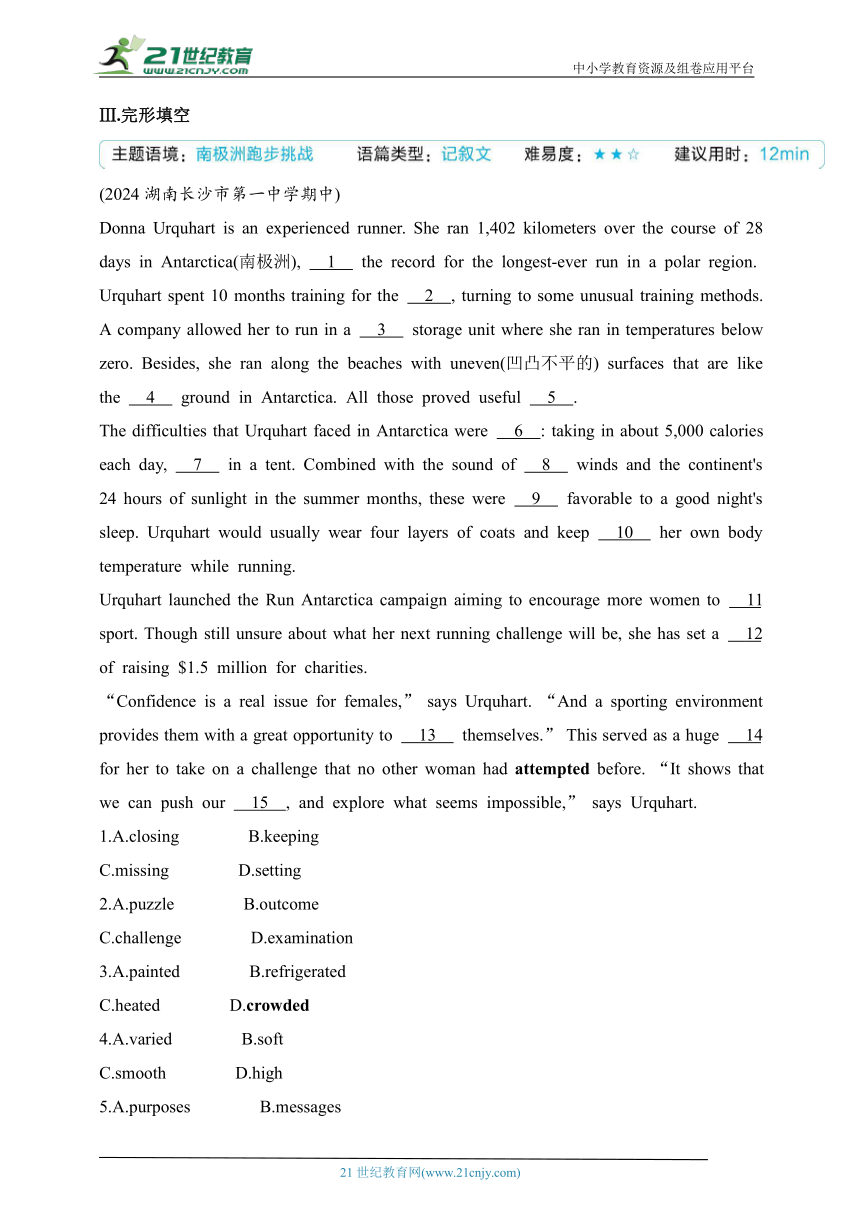
文档简介
中小学教育资源及组卷应用平台
2025外研版高中英语必修第三册
Unit 5 What an adventure!
Part 2 Using language
基础过关练
Ⅰ.单词拼写
1.It has been confirmed that the (橡胶)used in these tires is of the highest quality.
2.The government is drawing up some new (指导方针) on health and safety in schools.
3.When the two white (液体) are mixed together, they become blue at once.
4.The (棉布)shirt is comfortable and breathable for the hot summer days.
5.We need to transport these goods to the nearest p for export.
6.He drank so much a last night that he was totally drunk and missed the important meeting.
Ⅱ.单句语法填空
1.(2024四川成都蓉城名校联盟开学考试)The kids cheered, completely unaware the danger.
2.Frequent (bleed) from the nose can be a side effect of the new medication.
3.(2024山东临沂四中月考)He jumped off the boat and hit a sandbank, leading to a severe (injure) to his neck.
4.The forest, (stretch) for more than ten miles, is home to diverse wildlife.
Ⅲ.单元语法专练
题型(一)
1.Li Ming said he (be) happy if Brian came to China the next month.
2.The dark clouds in the sky meant that a storm (come).
3.(2024新课标Ⅰ)When I was about (give) up, Gunter fished out his little phone and rang up a friend.
4. Jack was so busy when we saw him, because he (make) a speech the next day.
5.I didn't know when she would come, but when she (come) I would let you know.
6.At college, Barack Obama didn't know that he (become)the first black president of the United States of America.
题型(二)
根据语境,用所给词的正确时态补全短文
Two years ago, my mom told me that she 1 (send) me to a private high school. I was so excited because I 2 (start) a new chapter of my life. But actually, the first two weeks at the new school was the most difficult time of my entire life.
I was so homesick and I didn't know how to cheer myself up. To turn my attention, I threw myself into my studies. I wanted to keep every part of my day busy, so I 3 (not think) about how lonely I felt. Gradually, I started to adapt myself to my new life. I just remember one afternoon, as I 4 (leave) the classroom after school, my Chinese teacher walked to me and said that all my hard work 5 (pay off) soon. Her words encouraged me greatly and made me more determined to make an effort.
Now I have entered my dream university. So if you put your effort into something,the result 6 (not disappoint) you.
1. 2. 3.
4. 5. 6.
能力提升练
Ⅰ.阅读理解
(2024山东德州夏津一中月考)
In 1880, fourteen-year-old Matthew Henson was fascinated by the tales of sailors' exciting lives at sea. One day he set out on the forty-mile journey to the nearest large port to seek work on a sailing ship.
In Baltimore, Henson found a job as a cabin boy on a beautiful ship called the Katie Hinds. For the next five years, Henson sailed around the world. By the time he left the Katie Hinds in 1885, Henson was well-educated, thus becoming an excellent seaman.
Unable to find work anywhere else, Henson took a job in a hat shop in Washington, D.C. One day in 1887, a man came in to buy a hat. The man, Robert Peary, asked the owner if he knew anyone with experience at sea. Peary would soon travel to South America for the U.S. government. He needed experienced men to accompany him.
The shop owner knew about his young employee's skills and experience on ocean voyages, so he introduced Peary to Henson. Henson and Peary soon found they had a great deal in common, including their love of the sea.
Using his map-reading and sailing skills, Henson proved himself to be a worthy and intelligent seaman. One day Peary told Henson about his real dream: to be the first man to stand on “the top of the world” at the North Pole. He asked Henson to help him make his dream come true.
Over the next five years, the two explorers made two trips together to the Arctic. However, they were not able to reach the pole each time.
In 1908, Peary and Henson were ready to make their final attempt at reaching the North Pole. Both men were over forty years old. The years of hardship and suffering in extreme cold had taken their toll on both men. This would be their last chance.
In April 1909, Henson's instruments showed they were standing at the North Pole. Together Henson and Peary planted an American flag in the snow. They were greatly honored for their achievement. Today, the two friends and fellow explorers lie in heroes' graves not far apart at Arlington National Cemetery.
1.What can we know about Henson from Paragraph 1
A.He was highly educated. B.He was skilled in sailing.
C.He used to travel at sea. D.He was interested in sea exploring.
2.What is Paragraph 3 mainly about
A.Why Matthew Henson went to the hat shop.
B.How Matthew Henson met Robert Peary.
C.Why Matthew Henson stopped working on the Katie Hinds.
D.How the shop owner knew that Matthew Henson had sea experience.
3.What does the underlined part mean in Paragraph 7
A.Helped them. B.Satisfied them.
C.Weakened them. D.Enlightened them.
4.What could the story between Henson and Peary be compared to
A.Sailors seeking power over others. B.Fighters exploring an unknown land.
C.Treasure hunters looking for fortunes. D.Soldiers fighting for their freedom.
Ⅱ.七选五
(2023广东深圳期中)
The Science of Risk-Seeking
Sometimes we decide that a little unnecessary danger is worth it because when we weigh the risk and the reward, the risk seems worth taking. 1 Some of us enjoy activities that would astonish and scare the rest of us. Why Experts say it may have to do with how our brains work.
The reason why we take risks might relate to early humans. Risk-takers were better at hunting, fighting, or exploring. 2 As the quality of risk-taking was passed from one generation to the next, humans ended up with a sense of adventure and tolerance for risk.
So why aren't we all jumping out of airplanes then Well, even 200,000 years ago, too much risk-taking could get one killed. A few daring survived, though, along with a few stay-in-the-cave types. As a result, humans developed a range of character types that still exists today. So maybe you love car racing, or maybe you hate it. 3
No matter where you are on the risk-seeking range, scientists say that your willingness to take risks increases during your teenage years. 4 To help you do that, your brain increases your hunger for new experiences. New experiences often mean taking some risks, so your brain raises your tolerance for risk as well.
5 For the risk-seekers, a part of the brain related to pleasure becomes active, while for the rest of us, a part of the brain related to fear becomes active.
As experts continue to study the science of risk-seeking, we'll continue to hit the mountains, the waves or the shallow end of the pool.
A.It all depends on your character.
B.Those are the risks you should jump to take.
C.Being better at those things meant a greater chance of survival.
D.Thus, these well-equipped people survived because they were the fittest.
E.This is when you start to move away from your family and into the bigger world.
F.However, we are not all using the same reference standard to weigh risks and rewards.
G.New brain research suggests our brains work differently when we face a nervous situation.
1. 2. 3. 4. 5.
Ⅲ.完形填空
(2024湖南长沙市第一中学期中)
Donna Urquhart is an experienced runner. She ran 1,402 kilometers over the course of 28 days in Antarctica(南极洲), 1 the record for the longest-ever run in a polar region.
Urquhart spent 10 months training for the 2 , turning to some unusual training methods. A company allowed her to run in a 3 storage unit where she ran in temperatures below zero. Besides, she ran along the beaches with uneven(凹凸不平的) surfaces that are like the 4 ground in Antarctica. All those proved useful 5 .
The difficulties that Urquhart faced in Antarctica were 6 : taking in about 5,000 calories each day, 7 in a bined with the sound of 8 winds and the continent's 24 hours of sunlight in the summer months, these were 9 favorable to a good night's sleep. Urquhart would usually wear four layers of coats and keep 10 her own body temperature while running.
Urquhart launched the Run Antarctica campaign aiming to encourage more women to 11 sport. Though still unsure about what her next running challenge will be, she has set a 12 of raising $1.5 million for charities.
“Confidence is a real issue for females,” says Urquhart. “And a sporting environment provides them with a great opportunity to 13 themselves.” This served as a huge 14 for her to take on a challenge that no other woman had attempted before. “It shows that we can push our 15 , and explore what seems impossible,” says Urquhart.
1.A.closing B.keeping
C.missing D.setting
2.A.puzzle B.outcome
C.challenge D.examination
3.A.painted B.refrigerated
C.heated D.crowded
4.A.varied B.soft
C.smooth D.high
5.A.purposes B.messages
C.preparations D.suggestions
6.A.new B.tough
C.interesting D.exciting
7.A.sleeping B.recovering
C.harvesting D.complaining
8.A.gentle B.slight
C.warm D.wild
9.A.likely B.gradually
C.hardly D.really
10.A.noticing B.taking
C.decreasing D.forgetting
11.A.refer to B.apply for
C.carry on D.take up
12.A.price B.record
C.target D.rule
13.A.support B.trust
C.prevent D.wait
14.A.inspiration B.impression
C.symbol D.adventure
15.A.processes B.positions
C.schedules D.limits
答案与分层梯度式解析
Unit 5 What an adventure!
Part 2 Using language
基础过关练
Ⅰ.1.rubber 2.guidelines 3.liquids 4.cotton 5.port
6.alcohol
Ⅱ.1.of 考查介词。句意:孩子们欢呼起来,完全没有意识到危险。be unaware of意为“没意识到……”。此处用形容词短语作伴随状语。
2.bleeding 考查名词。句意:频繁的鼻子出血可能是这种新药的副作用。根据空前形容词Frequent可知,本空应用名词bleeding,意为“流血,失血”。
3.injury 考查名词。句意:他从船上跳下,撞上了一个沙洲,导致颈部严重受伤。本空作leading to的宾语,根据空前a severe可知,本空应用可数名词单数injury,意为“伤害;损伤”。
4.stretching 考查非谓语动词。句意:这片森林绵延十多英里,是各种野生动物的家园。分析句子可知,句中已有谓语动词,所以设空处应用非谓语动词,句子主语The forest和动词stretch之间为主动关系,故本空应用现在分词形式。故填stretching。
Ⅲ.题型(一)
1.would be 考查过去将来时。句意:李明说如果布赖恩下个月来中国,他将会很高兴。根据语境可知,此处应用过去将来时,故填would be。
2.was coming 考查过去进行时代替过去将来时。句意:天空中的乌云预示暴风雨即将来临。was/were doing sth.表示过去将来时,多用于go、come、leave、start等表位移的动词,表示过去将要发生的情况。
3.to give 考查固定结构。句意:当我正要放弃的时候,Gunter拿出他的小手机,给一个朋友打了电话。be about to do sth.意为“正要做某事”,故本空应用不定式形式。
4.would make 考查过去将来时。句意:我们见到杰克时他很忙,因为他第二天要发表演讲。根据时间状语the next day可知此处表示过去将要发生的动作,应用过去将来时,故填would make。
5.came 考查一般过去时表示过去将来。句意:我不知道她什么时候来,但她来了我会告诉你。分析句子可知,but后的分句中主句I would let you know用的是过去将来时,所以when引导的时间状语从句应用一般过去时表示过去将来,故填came。
6.would become 考查过去将来时。句意:在大学时,贝拉克·奥巴马不知道他将成为美国第一位黑人总统。根据句意可知,应用过去将来时,故填would become。
题型(二)
1.would send/was going to send 2.would start
3.wouldn't think 4.was about to leave 5.would pay off
6.won't disappoint
能力提升练
Ⅰ.◎语篇解读 本文是一篇记叙文。文章讲述了一位名叫马修·亨森的人在年轻时追求航海生涯,在一艘船上工作了五年,积累了丰富的航海经验。后来,他遇到了罗伯特·皮里,并与他一起前往北极探险。经过多年的努力,他们在1909年成功到达了北极,成为英雄。
1.D 细节理解题。根据第一段中“In 1880, fourteen-year-old Matthew Henson was fascinated by the tales of sailors' exciting lives at sea.”可知,马修·亨森对海上探险非常感兴趣。故选D。
2.B 主旨大意题。根据第三段中“One day in 1887, a man came in to buy a hat...He needed experienced men to accompany him.(1887年的一天,一个男人进来买帽子。这名男子是罗伯特·皮里,他问店主是否认识有海上经验的人。皮里不久将代表美国政府前往南美洲。他需要有经验的人陪伴他。)”可知,本段主要讲述了马修·亨森和罗伯特·皮里是如何遇到的。故选B。
3.C 词义猜测题。根据画线部分前“In 1908, Peary and Henson were ready to make their final attempt at reaching the North Pole. Both men were over forty years old.”以及“The years of hardship and suffering”可知,两人为了到达北极经历了许多艰苦的岁月,两人都已经年过四十了。由此推知,多年的艰苦困境不断地消磨着他们,削弱着他们。故画线部分与C项“削弱了他们”为同义表达。故选C。
4.B 推理判断题。根据最后一段中“In April 1909, Henson's instruments showed they were standing at the North Pole. Together Henson and Peary planted an American flag in the snow.”可知,二人经过努力,最终成功到达了北极。这个旅途非常艰难,两个人都吃了不少的苦头。由此推知,整个过程就像战士们在探索未知的土地。故选B。
【高频词汇】 1.set out启程;出发 2.accompany v.陪同,陪伴 3.have a great deal in common有很多共同之处 4.worthy adj.优秀的;值得尊敬的 5.hardship n.困难,艰苦
Ⅱ.◎语篇解读 这是一篇说明文。文章介绍了人们喜欢冒险的来源和科学依据。人们喜欢冒险,因为风险也意味着回报,生活中人们喜欢做一些让别人惊讶和害怕的事,这和人的大脑有关。
1.F 根据上文“Sometimes we decide...the risk seems worth taking.”可知,有时,我们认为一点不必要的危险是值得的,因为当我们权衡风险和回报时,风险似乎是值得承担的。F项(然而,我们并不是完全使用相同的参考标准来衡量风险和回报。)承接上文,形成转折关系。F项中的“weigh risks and rewards”和上文中“weigh the risk and the reward”呼应。
2.C 根据上文“Risk-takers were better at hunting, fighting, or exploring.”可知,冒险者更擅长打猎、打架或探险。C项(在那些方面做得更好意味着生存的机会更大。)承接上文。C项中的“Being better at those things”和上文中的“were better at hunting, fighting, or exploring”呼应。
3.A 根据上文“As a result...or maybe you hate it.”可知,人类形成了一系列至今仍然存在的性格类型,所以,也许你喜欢赛车,也许你讨厌赛车。A项(这都依据你的性格。)承接上文。A项中的“character”和上文中的“a range of character types”呼应。
4.E 根据上文“scientists say that your willingness to take risks increases during your teenage years(科学家说,在你十几岁的时候,你冒险的意愿会增加)”和下文“To help you do that, your brain increases your hunger for new experiences.(为了帮你做那件事,你的大脑会增加你对新的体验的渴望。)”可知,E项(这是当你开始离开你的家庭,走进更大的世界的时候。)承接上下文,符合语境。
5.G 根据下文“For the risk-seekers...becomes active.(对于寻求冒险的人来说,大脑中与快乐有关的部分变得活跃;而对于我们其他人来说,大脑中与恐惧有关的部分变得活跃。)”可知,不同的人的大脑在面对风险时表现会不一样。G项(新的大脑研究表明,当我们面对紧张的情况时,我们的大脑会以不同的方式工作。)承接下文。
【高频词汇】 1.reward n.回报 2.scare vt.使惊恐
3.end up with以……结束 4.tolerance n.容忍,忍受
5.along with和……一起 6.a range of一系列
【熟词生义】 1.weigh vt.认真考虑;权衡 2.hit vt.到达(某地)
长难句
原句 For the risk-seekers, a part of the brain related to pleasure becomes active, while for the rest of us, a part of the brain related to fear becomes active.
分析 本句为并列复合句,while连接前后两个并列分句,while意为“而,然而”,表示对比。“related to pleasure”与“related to fear”为形容词短语作后置定语。
译文 对于寻求风险的人来说,大脑中与快乐相关的部分变得活跃起来,而对于我们其他人来说,大脑中与恐惧相关的部分变得活跃起来。
Ⅲ.◎语篇解读 本文是一篇记叙文。文章讲述了Donna Urquhart的南极洲跑步挑战以及她通过这项挑战传递的积极信息。
1.D 根据上文“She ran 1,402 kilometers over the course of 28 days in Antarctica”和下文“the record”可知,她在28天里跑了1,402千米,创下了纪录。set a record意为“创纪录”。close关闭;keep保持;miss错过。
2.C 根据上文“She ran 1,402 kilometers over the course of 28 days in Antarctica”可知,她在南极洲用28天跑了1,402千米,这对于她来说是一个很大的挑战(challenge)。puzzle难题;outcome结果;examination考试。
3.B 根据下文“where she ran in temperatures below zero”可知,一家公司允许她在零下的温度下在冷藏储存室中跑步。a refrigerated storage unit意为“冷藏储存室”。painted刷上油漆的;heated加热了的;crowded拥挤的。
4.A 根据上文“along the beaches with uneven surfaces”可知,她在凹凸不平的海滩跑步,海滩的表面就像南极洲各种各样的(varied)地面一样。 soft柔软的;smooth光滑的;high高的。
5.C 根据上文“Urquhart spent 10 months training for the 2 ”可知,前面描述的一系列的训练其实就是准备工作,因此所有那些都证明是有用的准备工作(preparations)。purpose目的;message信息;suggestion建议。
6.B 根据下文“taking in about 5,000 calories each day”可知,她每天摄入大约五千卡路里的热量,这是很艰难的(tough)。new新的;interesting有趣的;exciting令人兴奋的。
7.A 根据空后“in a tent”可知,她住(sleeping)在帐篷里。recover恢复;harvest收获;complain抱怨。
8.D 根据上文“The difficulties that Urquhart faced in Antarctica”可知,她在南极洲,耳边是狂(wild)风的声音。gentle温柔的;slight轻微的;warm温暖的。
9.C 根据上文“the sound of 8 winds and the continent's 24 hours of sunlight in the summer months”可知,狂风的声音和南极洲夏季24小时的阳光都对睡觉是不利的,设空处是“几乎不”的意思。故选C。likely可能地;gradually逐渐地;really真正地。
10.A 根据下文“her own body temperature while running”可知,她跑步时要不断注意(noticing)自己的体温。take拿走;decrease减少;forget忘记。
11.D 根据上文“Urquhart launched the Run Antarctica campaign aiming to encourage more women to”可知,她发起“Run Antarctica”活动是为了鼓励女性开始运动。 take up意为“开始从事某项活动”,符合语境。 refer to提到;apply for申请;carry on继续。
12.C 结合语境可知,虽然她还不确定她的下一个跑步挑战是什么,但她已经设定了为慈善机构筹集150万美元的目标(target)。price价格;record记录;rule规则。
13.B 根据上文“Confidence is a real issue for females”可知,自信对女性来说是一个真正的问题,体育环境为女性提供了一个很好的机会去相信(trust)自己。support支持;prevent阻止;wait等待。
14.A 根据下文“take on a challenge that no other woman had attempted before”可知,她因受到了鼓舞(inspiration),所以才接受了其他女性从未尝试过的挑战。impression印象;symbol象征;adventure冒险。
15.D 根据下文“explore what seems impossible”可知,我们突破极限(limits),然后探索看似不可能的事情。 process过程;position位置;schedule时间表。
【高频词汇】 1.over the course of...在……期间 2.take in摄入,吸收 3.favorable adj.有利的 4.layer n.层
5.launch v.开始从事,发起,发动(尤指有组织的活动)
6.serve as充当 7.take on a challenge接受挑战
21世纪教育网 www.21cnjy.com 精品试卷·第 2 页 (共 2 页)
21世纪教育网(www.21cnjy.com)
2025外研版高中英语必修第三册
Unit 5 What an adventure!
Part 2 Using language
基础过关练
Ⅰ.单词拼写
1.It has been confirmed that the (橡胶)used in these tires is of the highest quality.
2.The government is drawing up some new (指导方针) on health and safety in schools.
3.When the two white (液体) are mixed together, they become blue at once.
4.The (棉布)shirt is comfortable and breathable for the hot summer days.
5.We need to transport these goods to the nearest p for export.
6.He drank so much a last night that he was totally drunk and missed the important meeting.
Ⅱ.单句语法填空
1.(2024四川成都蓉城名校联盟开学考试)The kids cheered, completely unaware the danger.
2.Frequent (bleed) from the nose can be a side effect of the new medication.
3.(2024山东临沂四中月考)He jumped off the boat and hit a sandbank, leading to a severe (injure) to his neck.
4.The forest, (stretch) for more than ten miles, is home to diverse wildlife.
Ⅲ.单元语法专练
题型(一)
1.Li Ming said he (be) happy if Brian came to China the next month.
2.The dark clouds in the sky meant that a storm (come).
3.(2024新课标Ⅰ)When I was about (give) up, Gunter fished out his little phone and rang up a friend.
4. Jack was so busy when we saw him, because he (make) a speech the next day.
5.I didn't know when she would come, but when she (come) I would let you know.
6.At college, Barack Obama didn't know that he (become)the first black president of the United States of America.
题型(二)
根据语境,用所给词的正确时态补全短文
Two years ago, my mom told me that she 1 (send) me to a private high school. I was so excited because I 2 (start) a new chapter of my life. But actually, the first two weeks at the new school was the most difficult time of my entire life.
I was so homesick and I didn't know how to cheer myself up. To turn my attention, I threw myself into my studies. I wanted to keep every part of my day busy, so I 3 (not think) about how lonely I felt. Gradually, I started to adapt myself to my new life. I just remember one afternoon, as I 4 (leave) the classroom after school, my Chinese teacher walked to me and said that all my hard work 5 (pay off) soon. Her words encouraged me greatly and made me more determined to make an effort.
Now I have entered my dream university. So if you put your effort into something,the result 6 (not disappoint) you.
1. 2. 3.
4. 5. 6.
能力提升练
Ⅰ.阅读理解
(2024山东德州夏津一中月考)
In 1880, fourteen-year-old Matthew Henson was fascinated by the tales of sailors' exciting lives at sea. One day he set out on the forty-mile journey to the nearest large port to seek work on a sailing ship.
In Baltimore, Henson found a job as a cabin boy on a beautiful ship called the Katie Hinds. For the next five years, Henson sailed around the world. By the time he left the Katie Hinds in 1885, Henson was well-educated, thus becoming an excellent seaman.
Unable to find work anywhere else, Henson took a job in a hat shop in Washington, D.C. One day in 1887, a man came in to buy a hat. The man, Robert Peary, asked the owner if he knew anyone with experience at sea. Peary would soon travel to South America for the U.S. government. He needed experienced men to accompany him.
The shop owner knew about his young employee's skills and experience on ocean voyages, so he introduced Peary to Henson. Henson and Peary soon found they had a great deal in common, including their love of the sea.
Using his map-reading and sailing skills, Henson proved himself to be a worthy and intelligent seaman. One day Peary told Henson about his real dream: to be the first man to stand on “the top of the world” at the North Pole. He asked Henson to help him make his dream come true.
Over the next five years, the two explorers made two trips together to the Arctic. However, they were not able to reach the pole each time.
In 1908, Peary and Henson were ready to make their final attempt at reaching the North Pole. Both men were over forty years old. The years of hardship and suffering in extreme cold had taken their toll on both men. This would be their last chance.
In April 1909, Henson's instruments showed they were standing at the North Pole. Together Henson and Peary planted an American flag in the snow. They were greatly honored for their achievement. Today, the two friends and fellow explorers lie in heroes' graves not far apart at Arlington National Cemetery.
1.What can we know about Henson from Paragraph 1
A.He was highly educated. B.He was skilled in sailing.
C.He used to travel at sea. D.He was interested in sea exploring.
2.What is Paragraph 3 mainly about
A.Why Matthew Henson went to the hat shop.
B.How Matthew Henson met Robert Peary.
C.Why Matthew Henson stopped working on the Katie Hinds.
D.How the shop owner knew that Matthew Henson had sea experience.
3.What does the underlined part mean in Paragraph 7
A.Helped them. B.Satisfied them.
C.Weakened them. D.Enlightened them.
4.What could the story between Henson and Peary be compared to
A.Sailors seeking power over others. B.Fighters exploring an unknown land.
C.Treasure hunters looking for fortunes. D.Soldiers fighting for their freedom.
Ⅱ.七选五
(2023广东深圳期中)
The Science of Risk-Seeking
Sometimes we decide that a little unnecessary danger is worth it because when we weigh the risk and the reward, the risk seems worth taking. 1 Some of us enjoy activities that would astonish and scare the rest of us. Why Experts say it may have to do with how our brains work.
The reason why we take risks might relate to early humans. Risk-takers were better at hunting, fighting, or exploring. 2 As the quality of risk-taking was passed from one generation to the next, humans ended up with a sense of adventure and tolerance for risk.
So why aren't we all jumping out of airplanes then Well, even 200,000 years ago, too much risk-taking could get one killed. A few daring survived, though, along with a few stay-in-the-cave types. As a result, humans developed a range of character types that still exists today. So maybe you love car racing, or maybe you hate it. 3
No matter where you are on the risk-seeking range, scientists say that your willingness to take risks increases during your teenage years. 4 To help you do that, your brain increases your hunger for new experiences. New experiences often mean taking some risks, so your brain raises your tolerance for risk as well.
5 For the risk-seekers, a part of the brain related to pleasure becomes active, while for the rest of us, a part of the brain related to fear becomes active.
As experts continue to study the science of risk-seeking, we'll continue to hit the mountains, the waves or the shallow end of the pool.
A.It all depends on your character.
B.Those are the risks you should jump to take.
C.Being better at those things meant a greater chance of survival.
D.Thus, these well-equipped people survived because they were the fittest.
E.This is when you start to move away from your family and into the bigger world.
F.However, we are not all using the same reference standard to weigh risks and rewards.
G.New brain research suggests our brains work differently when we face a nervous situation.
1. 2. 3. 4. 5.
Ⅲ.完形填空
(2024湖南长沙市第一中学期中)
Donna Urquhart is an experienced runner. She ran 1,402 kilometers over the course of 28 days in Antarctica(南极洲), 1 the record for the longest-ever run in a polar region.
Urquhart spent 10 months training for the 2 , turning to some unusual training methods. A company allowed her to run in a 3 storage unit where she ran in temperatures below zero. Besides, she ran along the beaches with uneven(凹凸不平的) surfaces that are like the 4 ground in Antarctica. All those proved useful 5 .
The difficulties that Urquhart faced in Antarctica were 6 : taking in about 5,000 calories each day, 7 in a bined with the sound of 8 winds and the continent's 24 hours of sunlight in the summer months, these were 9 favorable to a good night's sleep. Urquhart would usually wear four layers of coats and keep 10 her own body temperature while running.
Urquhart launched the Run Antarctica campaign aiming to encourage more women to 11 sport. Though still unsure about what her next running challenge will be, she has set a 12 of raising $1.5 million for charities.
“Confidence is a real issue for females,” says Urquhart. “And a sporting environment provides them with a great opportunity to 13 themselves.” This served as a huge 14 for her to take on a challenge that no other woman had attempted before. “It shows that we can push our 15 , and explore what seems impossible,” says Urquhart.
1.A.closing B.keeping
C.missing D.setting
2.A.puzzle B.outcome
C.challenge D.examination
3.A.painted B.refrigerated
C.heated D.crowded
4.A.varied B.soft
C.smooth D.high
5.A.purposes B.messages
C.preparations D.suggestions
6.A.new B.tough
C.interesting D.exciting
7.A.sleeping B.recovering
C.harvesting D.complaining
8.A.gentle B.slight
C.warm D.wild
9.A.likely B.gradually
C.hardly D.really
10.A.noticing B.taking
C.decreasing D.forgetting
11.A.refer to B.apply for
C.carry on D.take up
12.A.price B.record
C.target D.rule
13.A.support B.trust
C.prevent D.wait
14.A.inspiration B.impression
C.symbol D.adventure
15.A.processes B.positions
C.schedules D.limits
答案与分层梯度式解析
Unit 5 What an adventure!
Part 2 Using language
基础过关练
Ⅰ.1.rubber 2.guidelines 3.liquids 4.cotton 5.port
6.alcohol
Ⅱ.1.of 考查介词。句意:孩子们欢呼起来,完全没有意识到危险。be unaware of意为“没意识到……”。此处用形容词短语作伴随状语。
2.bleeding 考查名词。句意:频繁的鼻子出血可能是这种新药的副作用。根据空前形容词Frequent可知,本空应用名词bleeding,意为“流血,失血”。
3.injury 考查名词。句意:他从船上跳下,撞上了一个沙洲,导致颈部严重受伤。本空作leading to的宾语,根据空前a severe可知,本空应用可数名词单数injury,意为“伤害;损伤”。
4.stretching 考查非谓语动词。句意:这片森林绵延十多英里,是各种野生动物的家园。分析句子可知,句中已有谓语动词,所以设空处应用非谓语动词,句子主语The forest和动词stretch之间为主动关系,故本空应用现在分词形式。故填stretching。
Ⅲ.题型(一)
1.would be 考查过去将来时。句意:李明说如果布赖恩下个月来中国,他将会很高兴。根据语境可知,此处应用过去将来时,故填would be。
2.was coming 考查过去进行时代替过去将来时。句意:天空中的乌云预示暴风雨即将来临。was/were doing sth.表示过去将来时,多用于go、come、leave、start等表位移的动词,表示过去将要发生的情况。
3.to give 考查固定结构。句意:当我正要放弃的时候,Gunter拿出他的小手机,给一个朋友打了电话。be about to do sth.意为“正要做某事”,故本空应用不定式形式。
4.would make 考查过去将来时。句意:我们见到杰克时他很忙,因为他第二天要发表演讲。根据时间状语the next day可知此处表示过去将要发生的动作,应用过去将来时,故填would make。
5.came 考查一般过去时表示过去将来。句意:我不知道她什么时候来,但她来了我会告诉你。分析句子可知,but后的分句中主句I would let you know用的是过去将来时,所以when引导的时间状语从句应用一般过去时表示过去将来,故填came。
6.would become 考查过去将来时。句意:在大学时,贝拉克·奥巴马不知道他将成为美国第一位黑人总统。根据句意可知,应用过去将来时,故填would become。
题型(二)
1.would send/was going to send 2.would start
3.wouldn't think 4.was about to leave 5.would pay off
6.won't disappoint
能力提升练
Ⅰ.◎语篇解读 本文是一篇记叙文。文章讲述了一位名叫马修·亨森的人在年轻时追求航海生涯,在一艘船上工作了五年,积累了丰富的航海经验。后来,他遇到了罗伯特·皮里,并与他一起前往北极探险。经过多年的努力,他们在1909年成功到达了北极,成为英雄。
1.D 细节理解题。根据第一段中“In 1880, fourteen-year-old Matthew Henson was fascinated by the tales of sailors' exciting lives at sea.”可知,马修·亨森对海上探险非常感兴趣。故选D。
2.B 主旨大意题。根据第三段中“One day in 1887, a man came in to buy a hat...He needed experienced men to accompany him.(1887年的一天,一个男人进来买帽子。这名男子是罗伯特·皮里,他问店主是否认识有海上经验的人。皮里不久将代表美国政府前往南美洲。他需要有经验的人陪伴他。)”可知,本段主要讲述了马修·亨森和罗伯特·皮里是如何遇到的。故选B。
3.C 词义猜测题。根据画线部分前“In 1908, Peary and Henson were ready to make their final attempt at reaching the North Pole. Both men were over forty years old.”以及“The years of hardship and suffering”可知,两人为了到达北极经历了许多艰苦的岁月,两人都已经年过四十了。由此推知,多年的艰苦困境不断地消磨着他们,削弱着他们。故画线部分与C项“削弱了他们”为同义表达。故选C。
4.B 推理判断题。根据最后一段中“In April 1909, Henson's instruments showed they were standing at the North Pole. Together Henson and Peary planted an American flag in the snow.”可知,二人经过努力,最终成功到达了北极。这个旅途非常艰难,两个人都吃了不少的苦头。由此推知,整个过程就像战士们在探索未知的土地。故选B。
【高频词汇】 1.set out启程;出发 2.accompany v.陪同,陪伴 3.have a great deal in common有很多共同之处 4.worthy adj.优秀的;值得尊敬的 5.hardship n.困难,艰苦
Ⅱ.◎语篇解读 这是一篇说明文。文章介绍了人们喜欢冒险的来源和科学依据。人们喜欢冒险,因为风险也意味着回报,生活中人们喜欢做一些让别人惊讶和害怕的事,这和人的大脑有关。
1.F 根据上文“Sometimes we decide...the risk seems worth taking.”可知,有时,我们认为一点不必要的危险是值得的,因为当我们权衡风险和回报时,风险似乎是值得承担的。F项(然而,我们并不是完全使用相同的参考标准来衡量风险和回报。)承接上文,形成转折关系。F项中的“weigh risks and rewards”和上文中“weigh the risk and the reward”呼应。
2.C 根据上文“Risk-takers were better at hunting, fighting, or exploring.”可知,冒险者更擅长打猎、打架或探险。C项(在那些方面做得更好意味着生存的机会更大。)承接上文。C项中的“Being better at those things”和上文中的“were better at hunting, fighting, or exploring”呼应。
3.A 根据上文“As a result...or maybe you hate it.”可知,人类形成了一系列至今仍然存在的性格类型,所以,也许你喜欢赛车,也许你讨厌赛车。A项(这都依据你的性格。)承接上文。A项中的“character”和上文中的“a range of character types”呼应。
4.E 根据上文“scientists say that your willingness to take risks increases during your teenage years(科学家说,在你十几岁的时候,你冒险的意愿会增加)”和下文“To help you do that, your brain increases your hunger for new experiences.(为了帮你做那件事,你的大脑会增加你对新的体验的渴望。)”可知,E项(这是当你开始离开你的家庭,走进更大的世界的时候。)承接上下文,符合语境。
5.G 根据下文“For the risk-seekers...becomes active.(对于寻求冒险的人来说,大脑中与快乐有关的部分变得活跃;而对于我们其他人来说,大脑中与恐惧有关的部分变得活跃。)”可知,不同的人的大脑在面对风险时表现会不一样。G项(新的大脑研究表明,当我们面对紧张的情况时,我们的大脑会以不同的方式工作。)承接下文。
【高频词汇】 1.reward n.回报 2.scare vt.使惊恐
3.end up with以……结束 4.tolerance n.容忍,忍受
5.along with和……一起 6.a range of一系列
【熟词生义】 1.weigh vt.认真考虑;权衡 2.hit vt.到达(某地)
长难句
原句 For the risk-seekers, a part of the brain related to pleasure becomes active, while for the rest of us, a part of the brain related to fear becomes active.
分析 本句为并列复合句,while连接前后两个并列分句,while意为“而,然而”,表示对比。“related to pleasure”与“related to fear”为形容词短语作后置定语。
译文 对于寻求风险的人来说,大脑中与快乐相关的部分变得活跃起来,而对于我们其他人来说,大脑中与恐惧相关的部分变得活跃起来。
Ⅲ.◎语篇解读 本文是一篇记叙文。文章讲述了Donna Urquhart的南极洲跑步挑战以及她通过这项挑战传递的积极信息。
1.D 根据上文“She ran 1,402 kilometers over the course of 28 days in Antarctica”和下文“the record”可知,她在28天里跑了1,402千米,创下了纪录。set a record意为“创纪录”。close关闭;keep保持;miss错过。
2.C 根据上文“She ran 1,402 kilometers over the course of 28 days in Antarctica”可知,她在南极洲用28天跑了1,402千米,这对于她来说是一个很大的挑战(challenge)。puzzle难题;outcome结果;examination考试。
3.B 根据下文“where she ran in temperatures below zero”可知,一家公司允许她在零下的温度下在冷藏储存室中跑步。a refrigerated storage unit意为“冷藏储存室”。painted刷上油漆的;heated加热了的;crowded拥挤的。
4.A 根据上文“along the beaches with uneven surfaces”可知,她在凹凸不平的海滩跑步,海滩的表面就像南极洲各种各样的(varied)地面一样。 soft柔软的;smooth光滑的;high高的。
5.C 根据上文“Urquhart spent 10 months training for the 2 ”可知,前面描述的一系列的训练其实就是准备工作,因此所有那些都证明是有用的准备工作(preparations)。purpose目的;message信息;suggestion建议。
6.B 根据下文“taking in about 5,000 calories each day”可知,她每天摄入大约五千卡路里的热量,这是很艰难的(tough)。new新的;interesting有趣的;exciting令人兴奋的。
7.A 根据空后“in a tent”可知,她住(sleeping)在帐篷里。recover恢复;harvest收获;complain抱怨。
8.D 根据上文“The difficulties that Urquhart faced in Antarctica”可知,她在南极洲,耳边是狂(wild)风的声音。gentle温柔的;slight轻微的;warm温暖的。
9.C 根据上文“the sound of 8 winds and the continent's 24 hours of sunlight in the summer months”可知,狂风的声音和南极洲夏季24小时的阳光都对睡觉是不利的,设空处是“几乎不”的意思。故选C。likely可能地;gradually逐渐地;really真正地。
10.A 根据下文“her own body temperature while running”可知,她跑步时要不断注意(noticing)自己的体温。take拿走;decrease减少;forget忘记。
11.D 根据上文“Urquhart launched the Run Antarctica campaign aiming to encourage more women to”可知,她发起“Run Antarctica”活动是为了鼓励女性开始运动。 take up意为“开始从事某项活动”,符合语境。 refer to提到;apply for申请;carry on继续。
12.C 结合语境可知,虽然她还不确定她的下一个跑步挑战是什么,但她已经设定了为慈善机构筹集150万美元的目标(target)。price价格;record记录;rule规则。
13.B 根据上文“Confidence is a real issue for females”可知,自信对女性来说是一个真正的问题,体育环境为女性提供了一个很好的机会去相信(trust)自己。support支持;prevent阻止;wait等待。
14.A 根据下文“take on a challenge that no other woman had attempted before”可知,她因受到了鼓舞(inspiration),所以才接受了其他女性从未尝试过的挑战。impression印象;symbol象征;adventure冒险。
15.D 根据下文“explore what seems impossible”可知,我们突破极限(limits),然后探索看似不可能的事情。 process过程;position位置;schedule时间表。
【高频词汇】 1.over the course of...在……期间 2.take in摄入,吸收 3.favorable adj.有利的 4.layer n.层
5.launch v.开始从事,发起,发动(尤指有组织的活动)
6.serve as充当 7.take on a challenge接受挑战
21世纪教育网 www.21cnjy.com 精品试卷·第 2 页 (共 2 页)
21世纪教育网(www.21cnjy.com)
